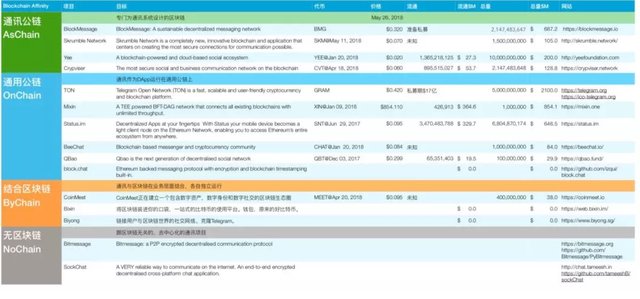Why IM not suitable for running on the public blockchain?
Why is Telegram's blockchain technology not friendly to communications?
Why does the communication system require a dedicated blockchain?
Whether you want to believe it or not, Telegram is about to complete the largest ICO in history, and has raised $1.7 billion without a public offering. That is because of its influence in ico, and its long-standing reputation in the communications industry. However, this series of articles does not go into the details of the token-related, but focusing on the technology behind the project, that is, the blockchain and communication system design.
This is the first in a series of articles about why it is not appropriate to make IM as DApp running directly on the public blockchain.
Where is the future of the blockchain?

The blockchain is triggering a new wave of technology, and the decentralization of services is overwhelming. Bitcoin demonstrates the operability of decentralized ledger technology, while the smart contracts added by Ethereum in Ethereum offer the possibility of implementing diverse services, but Many challenges when the explosive growth of technology applications also brings performance and scalability to the public blockchain.
Therefore, many blockchain projects such as IOTA, EOS, and TON have begun to scalability performance, and hope to make the public blockchain an operating system that supports all services, and meet various business needs at one time. This is a bold and innovative attempt, although it is far from enough in terms of engineering and efficiency.
At the same time, IPFS, NKN and other projects focus on the subdivision of storage and network, respectively, through the blockchain technology to reconstruct the underlying services, from the resource level to build the future value Internet IAAS platform. It shows that the blockchain is expanding from pure record-based technology to a broader field, and begins to participate in the distribution of value under the general scenario by adjusting economic incentives.
This is an important step in changing the relationship of production. From here on, the current high-value services of the Internet will have the opportunity to exist in a new and sustainable way of operation, becoming a ubiquitous on-demand infrastructure.
To put it simply, from a technical perspective, the future of the blockchain has three directions. One is the general public blockchain, which can do a lot of things while value-recording, and the second is to share resource pools, value-record, and reward the resource providers. The third is a vertical public blockchain, value-record, and rewards platform participants. Corresponding to the classical Internet scene, it is the operating system, cloud services, and platform-level applications.
This article discusses the third direction, platform-level applications.
Platform-level communication system requires blockchain

Whether a business is suitable for the blockchain can be viewed from the three dimensions of economy, business operation and technology.
First, from the economic point of view, whether there is an internal economic cycle, there is a demand for value-recording, there is a problem of value distribution; Second, from the business operation point of view, whether there is a problem of trust, whether there is a need for de-intermediation, further analysis of whether these problems and needs belong to the business Core scenarios; Third, technically, whether these problems and requirements can be used, needed or can only be solved by blockchain technology.
The communication platform built with IM chat service as the core, classical such as WeChat, blockchain era such as BlockMessage, is such a business. At the core of the social economy network is value exchange, which has natural value-recording needs. At the same time, as a new generation of social platform, in order to protect user data and privacy, in order to let the platform and application parties distribute the benefits in an equal manner, it is a business level. The core appeal; and in order to ensure the sustainable operation of communication services, the combination with blockchain technology is the best choice.
That is to say, with the decentralization of the blockchain, not only the platform services but also the platform organization are removed.
Driving communication services through blockchains has actually changed the way the original communication services are operated by separate organizations. The maintenance of communication services, from the original central organization providing funds and building infrastructure, to a mining method similar to maintaining distributed ledgers, is actually maintained by a large number of third parties involved in economic incentives.
what does this mean?
This means that there will be a social network that is fair and shared. There is no platform to control all application developers through monopoly communication services, and thus an equal ecosystem in which all applications participate in symbiosis sharing.
This means that there will also be a completely autonomous communication network that is serviced by communication nodes that are distributed by people around the world. All of this operation is driven by the value of the entire network and is not controlled by anyone.
Why do you need a communication public blockchain?

The public blockchain of communication is that this public blockchain is designed for communication, not a common public blockchain that can do anything, like OS in PC.
In general, in the field of technology, versatility means more advanced abstractions and often leads to performance or efficiency degradation. We carefully analyze the platform-level communication system requirements, and we can find three main reasons: operability, business applicability, and communication security.
Operability
Communication services and value-recording services, the magnitude of requests in the Internet scenario is completely different, usually the former is several orders of magnitude higher. Compared to blockchain value-recording, there is a lot of things to do with an Internet service. After a user visits, it seems that nothing is done. There may be many API requests in the Background system. Running the communication service directly on the blockchain means that all requests are on-chain, which puts higher demands on the public blockchain than value-recording.
Although many public blockchains are now working to solve this problem, there are also relatively mature programs like Sharding technology and DAG, but there is still far away from meeting the value-recording needs, not to mention meeting large-scale Communication needs.
Business applicability
Obviously, not all requests require a on-chain, because there is a cost to the value-record on chain. Although the blockchain operating system brings flexibility in implementation, it also turns all operations into a charging mode. This is acceptable for high-yield business scenarios, but for basic applications, this fundamentally shakes its model of relying on economies of scale to reduce marginal costs.
Just like cloud services for traditional server hosting, SaaS services for traditional applications, large applications rely on economies of scale to obtain additional economic benefits, which is the basis for maintaining competitive advantage.
Communication security
From a security perspective, communication behavior and information about circulation should not be on-chained. The blockchain is open and transparent for trust-free, but this is contrary to the communication needs. No one wants to talk to anyone who has talked about what has been published on the blockchain, even if they are encrypted.
Some people think that end-to-end encryption is enough. In fact, it is not necessarily that the friend relationship and network access path involved in communication behavior are important components of communication security.
In addition, from the past in technical applications, laboratory research will explore the limits of speed and performance, but large-scale applications often do not directly adopt the fastest technology, but tend to the most economical technology.
It’s not a good choice to kill a chicken with a knife and send a courier.
Communication IM project in the current blockchain field

One obvious thing is that not all IM applications are suitable for blockchains, and those that are suitable for blockchain resolution do not necessarily need to run on a distributed network of blockchains.
Especially at present, the development of blockchain has entered the outbreak of decentralized application DApp, and all walks of life are exploring the application of blockchain in business. There are already a lot of IM products on the market, which are dazzling. Each project will be simplified into a blockchain communication project during the discussion. However, in fact, their product and technology route choices are very different.
We conclude that these projects are basically divided into four categories:
Communication BlockChain Project AsChain
In these projects, communications as a foundational service operates with blockchains, which may focus on commercial networks, decentralized networks, or ecosystems. Such projects generally bind communication services to the ledger service through a consensus mechanism to complete the integration of billing and chat.
Representative projects: BlockMessage, Skrumble Network, CrypViser, Yee.
Universal BlockChain Project OnChain
These projects are all general-purpose public Blockchain products. Communication is only existed as a DApp running on all infrastructures of the public blockchain. That is to say, all messages are sent and received through a distributed network of blockchains. This approach belongs to the most primitive blockchain communication implementation, but as mentioned above, there are specific problems.
Representative projects: TON (Telegram Open Network), Mixin, Status, BeeChat, QBao.
Cryptocurrency Project ByChain
Cryptocurrency projects are basically wallet projects, and chat is only an aid. Their focus is on the discovery, trading and management of cryptocurrency, or on traditional Internet chat services, such as establishing more convenient transactions, group communication, group communication, etc., all of which are classical Internet products.
Representative projects: CoinMeet, Bixin, Biyong
Pure communication system project NoChain
Due to the popularity of the concept of decentralization, blockchain communication projects are often considered to be decentralized by default, so some decentralized communication projects are often mentioned. In fact, they have nothing to do with the blockchain.
Representative project: BitMessage.
See the figure below for a specific list:

It is not difficult to find that even in the same direction, different products have different emphasis on achieving route and product positioning. The choice of these subdivision paths depends entirely on the cognition and interest of the project sponsors, but has finally evolved into A completely different product lays the foundation.
In some projects, communication is a tool to assist in the completion of a core business. In other projects, communication is a platform, because it is to build a platform ecosystem, providing a communication channel as an infrastructure while providing a book service. .
The difference in vision is actually a difference in cognition, and it can be foreseen, and eventually it will go to different places.
About this article:
Article in Chinese:https://mp.weixin.qq.com/s/15Sw6KXGSUZxtv9NnYiXNg
Origial Writer: 一乐